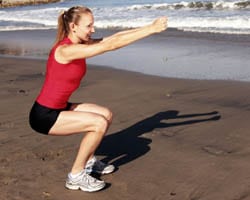
Squats are often called the king of all exercises, and for good reason. No other exercise works your entire body like the squat. Whether you’re trying to gain muscle or slim down, squats should be an integral part of your training repertoire.
Benefits of Squatting Include:
- Squats improve your posture
- Squats work all the major muscle groups
- Squats lift your butt and tone your thighs
- Squats increase your fat burning potential
- Squats dramatically strengthen your core stabilizers
The King of All Exercises?
The squat is a compound exercise that works your thighs, gluteal muscles, calves, core stabilizers, and (when done properly) even stimulates upper body growth. In fact, proper squats require the activation of almost every muscle in your body, from your feet all the way to your upper shoulder girdle.
"The squat is perhaps the most effective weight-training exercise for total-body development," says Michael Jocson, P.T., M.S., O.C.S., C.S.C.S., owner of Jocson Strength & Conditioning, in Howard Beach, N.Y. "The legs may be moving the body, but it takes a stable trunk and strong upper body to provide a foundation in which the legs can produce force. This is especially true when you start adding weights to your squats. Whether it be a back squat, front squat, split squat or overhead squat, many muscles of your whole body work in concert in order to lower and raise your center of gravity."
The squat not only builds your entire body, but it also builds mental toughness. Squats are one of the most dreaded exercises in the gym. They require you to step into a place that few are willing to go – what I call “the land of the uncomfortable”. However, once you have tackled the squat and met it head on, you will have a sense of accomplishment that is second to none.
Safety First
Because of its complex nature, proper form and technique is imperative when performing a squat. This is true for both safety and maximum development.
All beginners should start out with body weight squats; also known as “free” squats. You should practice free squats until you achieve proper muscle activation, proper alignment, and proper depth, which will enable you to squat properly with increased loads or resistance.
How to Squat
The squat, with or without weights, is a complex exercise that requires complete and total concentration. You’ll have to think about a lot of things, but they are all imperative to maintaining proper form and achieving rapid results.
Squat stance:
- Stand with feet slightly wider than hip width.
- Point toes out slightly (about 10 to 15 degrees).
- Head up.
- Chest up.
- Eyes and chin level with the horizon.
- Weight towards your heels.
- Keep off your insteps (towards the outer edge of your foot).
Squat descent (down):
- Maintain proper stance throughout the entire movement.
- Tense all the muscles in your body.
- Drive your hips back as if your were sitting into a chair or onto a toilet.
- Bend the knees as you lower your body.
- Flare your knees out keeping them in alignment with your toes.
- Squat down until your thighs are parallel to the ground.
- Keep all of the pressure through your heels and towards the outside of you foot.
Squat ascent (up):
- Do not relax your muscles or bounce.
- Maintain proper alignment (chest up, head up, etc.).
- Drive your heels into the floor.
- Keep your knees flared out.
- Drive your hips up.
- Squeeze your glutes and hip flexors.
Common problems with the squat:
- Leaning forward: This causes lower back pain, due to a lack of flexibility in the lower back or letting your hips come up faster than your shoulders.
- Knees drawn inward: This causes knee, ankle, and instep problems. Be sure to flare your knees out, keeping them in alignment with your toes.
- Rolling onto the balls of your feet: This causes knee damage, especially in the patellar tendon. Be sure to keep the pressure towards your heels.
- Knees too far forward: This causes knee damage. Be sure to keep your knees behind your toes.
- Rounded back: This causes back pain. Be sure to keep your chest up through the entire movement.
When done properly, the squat is the best exercise there is. However, squats can be very damaging when executed with improper form. So, follow the guidelines recommended, use proper form, and enjoy the vast benefits that the king of all exercises has to offer. For more information on squats, watch Naturally Savvy's Weight Loss Challange Part 2.










